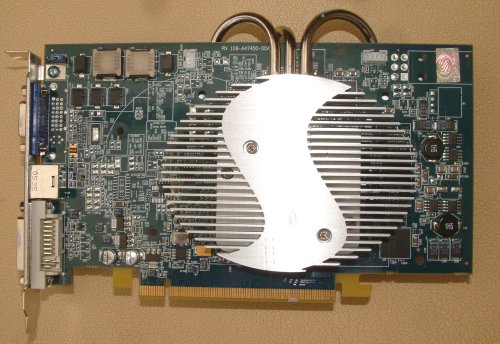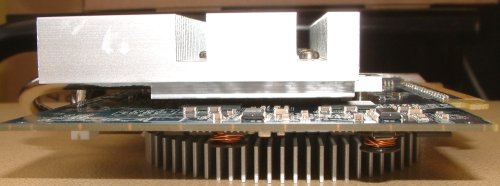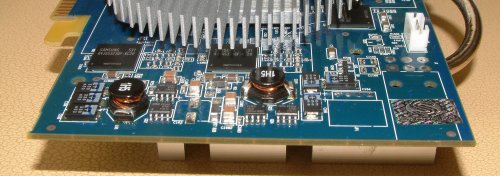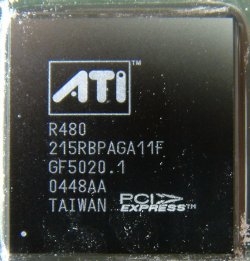Appearance and discussion
ATI's done a pretty good job of dumping new SKUs on the market. Differentiating between ATI's current high-end lineup is a task in itself.
| GPU | Radeon X800 GTO | Radeon X800 GT | Radeon X800 Pro | Radeon X800 XL | Radeon X850 Pro | Radeon X850 XT | Radeon X850 XT PE |
| Codename | R4xx | R4xx | R420 | R430 | R480 | R480 | R480 |
| Manufacturing process | 110nm/130nm* | 110nm/130nm* | 130nm low-k | 110nm | 130nm low-k | 130nm low-k | 130nm low-k |
| Native Interface | PCI-Express | PCI-Express | AGP | PCI-Express | PCI-Express | PCI-Express | PCI-Express | Core speed | 400MHz | 475MHz | 475MHz | 400MHz | 520MHz | 520MHz | 540MHz | Rendering pipelines | 12 | 8 | 12 | 16 | 12 | 16 | 16 | Memory buffer | 128MB/256MB | 128MB/256MB | 256MB | 256MB/512MB | 256MB | 256MB | 256MB | Memory speed | 700/980MHz | 700/980MHz | 900MHz | 980/980MHz | 1080MHz | 1080MHz | 1180MHz | Memory interface | 256-bit | 256-bit | 256-bit | 256-bit | 256-bit | 256-bit | 256-bit | Vertex shaders | 6 | 6 | 6 | 6 | 6 | 6 | 6 | Cheapest online price | £110/£120-£130 | £90/£100 | £150 | £185/265 | £210 | £230 | £260 |
The above isn't an exhaustive list of Radeon X8xx products but you get the picture, and that picture is one of taking the fastest card, the X850 XT PE, and then chopping off speed and rendering pipelines as we go further down the range. Note the similarities between SKUs. The X850 Pro is identical to a an X850 XT save for a three-quad setup. The X800 GTO 256MB is identical to an X800 XL 256MB save for, you've guessed it, a three-quad setup. In a nutshell, the X800 GTO will be slightly faster than the X800 GT. It has a slower core speed but more than compensates by having an extra 4 fragment processors (50% extra!). It will also be slower than an X800 XL due the lack of a fourth rendering quad. The £125-£135 pricing, however, makes it look attractive on paper.
ATI and its partners also offer the 'GTO with a 128MB onboard buffer. The £15-£20 reduction in overall cost is overshadowed by a severe lack of comparative performance. For one, the 128MB card uses DDR1 memory clocked in at a relatively lowly 700MHz. Secondly, the framebuffer isn't large enough when modern games are played at higher resolutions and/or with decent levels of antialiaising/anisotropic filtering.
SAPPHIRE Radeon X800 GTO Ultimate 256MB

Coming back to the card in question. SAPPHIRE appears to market at least 3 different X800 GTO 256MB cards. There's a regular X800 GTO 256MB, which uses a regular heatsink/fan combination. Then there's what's termed the FireBlade Special Edition, which uses faster DRAM that's clocked up at 1120MHz (effective), up from the default 980MHz. Then there's this card, the Ultimate Silent Series, which, as is obvious, is passively cooled. It's still set to run at a 256MB X800 GTO's default speeds of 400MHz core and 980MHz memory.

The funky SAPPHIRE-branded heatsink on the front is attached to a larger heatsink on the back via an established heatpipe method. The finned aluminium block absorbs the heat produced by the 400MHz-rated 12-pipeline core which is then carried over to the rear heatsink by 3 heatpipes. By doing this, SAPPHIRE's effectively increasing the surface area available for cooling. The rear heatsink is simply for cooling; it doesn't contact any card-mounted components at all. Dual heatsinks push the card's weight up to around 530g, so be sure to screw it into the case. Being an X800 GTO card, it's a PCI-Express-only affair. Users with AGP motherboards will probably not see an X800 GT/O released.

Note the huge rear-mounted heatsink.

The front shows the benefit of the PCI-Express interface, which is the sole interface X800 GTOs ship with. Enough juice is pumped through the slot as to not need an auxillary power connector. With the card's passively-cooled design that spits out heat into the case, we wouldn't recommend running it, in an overclocked fashion, in cases with small internal dimensions. Shuttle XPCs come to mind. It would also make a deal of common sense to have a well-ventilated case.

No VIVO on this model means that it's regular VGA, S-Video (TV-Out), and DVI-I.

A better view of the back of the card shows just how much space the heatsink takes up. Like the GPU heatsink, the rear comes in two parts, necessary to sandwich the 3 heatpipes that you see. SAPPHIRE's applied bountiful thermal interface material between the heatpipes and heatsinks, too.
We bet you're wondering exactly what's underneath that large heatsink? Stripping away the two heatsinks reveals a generic-looking PCB that has 4 DRAM devices on either side. However, remove the generous amount of TIM that's hiding the core reveals:

That's right. This sample uses an R480 core that ATI had envisaged would pop right into an X850-class of card. What can we expect in terms of overclocking, we wonder? X800 GTOs will use a variety of supposedly defective cores, with obvious choices being R423, R430, and R480. It's quite telling that ATI's Information Center correctly identifies the core as an X850-class of GPU.

SAPPHIRE uses 8 256Mbit memory chips from Samsung. The K4J55323QF-GC20 variety is as common as muck, with most AIBs going for the same when specifying DRAM that's run at around the 1000MHz mark. The X800 GTO 256MB Ultimate card, then, is a silent model that should benchmark somewhere between X800 GT 256MB and X800 XL 256MB SKUs.









